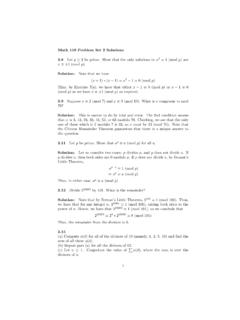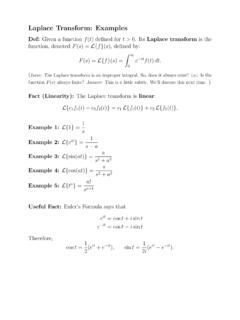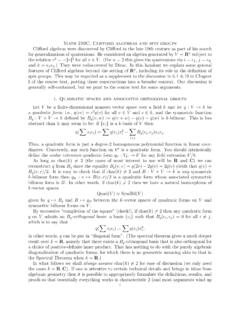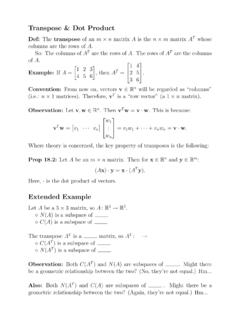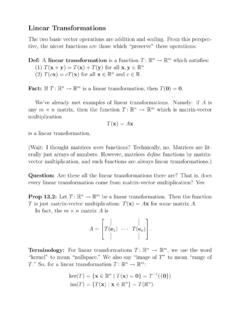Transcription of Homework 3 Solutions - Stanford University
1 Homework 3 Solutions Math 171, Spring 2010. Please send corrections to Let {an } be a sequence with positive terms such that limn an = L > 0. Let x be a real number. Prove that limn axn = Lx . Solution. Let > 0. By Theorem , note that L < (Lx + )1/x and L > (Lx )1/x . Since limn an = L, there exists some N such that n N implies an < (Lx + )1/x and an > (Lx )1/x . Hence by Theorem , for n N we have axn < Lx + and axn > Lx . This shows limn axn = Lx . Let 0 < 1, and let f be a function from R R which satisfies |f (x) f (y)| |x y|. for all x, y, R. Let a1 R, and let an+1 = f (an ) for n = 1, 2, .. Prove that {an } is a Cauchy sequence . Solution. First we prove by induction on n that |an+1 an | n 1 |a2 a1 | for all n N. The base case n = 1 is obvious.
2 Assuming the formula is true when n = k, we show it is true for n = k + 1: |ak+2 ak+1 | = |f (ak+1 ) f (ak )| |ak+1 ak | k 1 |a2 a1 | = k |a2 a1 |. Hence, by induction, this formula is true for all n. Note that if |a2 a1 | = 0, then an = a1 for all n, and so the sequence is clearly Cauchy. Hence we (1 ). 6 0. Now, given any > 0, pick N such that N 1 < |a consider the case when |a2 a1 | = 2 a1 |. , which n we can do because 0 < 1 = limn = 0. Then, for any m, n N , with m n, we have m 1. X. |am an | |ai+1 ai | by the triangle inequality i=n m 1. X. i 1 |a2 a1 | by our formula above i=n m 1. X. = |a2 a1 | i 1. i=n . X. |a2 a1 | i 1. i=N. N 1. = |a2 a1 | by the formula for the sum of an infinite geometric series 1 . < by our choice of N. Hence {an } is a Cauchy sequence .
3 Compute lim supn an and lim inf n an , where an is .. Solution. (a) n1. 1. 1 1 1. Since we know limn n = 0, we know lim supn n = 0 = lim inf n n by Theorem (b) (1 + n1 )n Since we know limn (1 + n1 )n = e, we know lim supn (1 + n1 )n = e = lim inf n (1 + n1 )n by Theorem (c) ( 1)n (1 n1 ). Since 1 (1+ n1 )n 1 for all n, we have lim inf n (1+ n1 )n 1 and lim supn (1+ n1 )n 1. Since the subsequence {a2n 1 } has limit 1 and the subsequence {a2n } has limit 1, we have lim inf n (1 + n1 )n 1 and lim supn (1 + n1 )n 1. Hence lim inf n (1 + n1 )n = 1 and lim supn (1 + n1 )n = 1. Compute lim supn an and lim inf n an and La , where a1 , a2 , .. is an enumeration of the ra- tional numbers in the closed interval [0, 1]. Solution. We show that La = [0, 1].
4 It is easy to show La [0, 1]. To show La [0, 1], let s [0, 1]. First we consider the case s > 0. By Theorem, , there exists an increasing rational sequence {rn } with limit s. As s > 0, for n sufficiently large we have rn 0, so we may assume that rn 0 for all n, hence rn [0, 1] for all n. By induction on n, we define a sequence {bn } which is a subsequence of both {an } and {rn }. For the base case, set b1 = r1 = ak for some integer k. For the inductive step, suppose we have defined b1 , .. , bn and bn = rl = ak . Since a1 , a2 , .. is an enumeration of the rational numbers, and since the set {rl+1 , rl+1 , .. } is infinite but {a1 , .. ak } is finite, there exists some k 0 > k such that ak0 = rl0 for some l0 > l. Set bn+1 = rl0 = ak0 . Note that {bn } is a subsequence of both {an } and {rn }.
5 Since {bn } is a subsequence of {rn }, we have limn bn = limn rn = s. Since {bn } is a subsequence of {an }, this shows s La . The case s = 0 is analogous. Hence La [0, 1], so La = [0, 1]. Since La = [0, 1], we have lim supn an = lub La = 1 and lim inf n an = glb La = 0. Let {an } be a bounded sequence such that every convergent subsequence of {an } has a limit L. Prove that limn an = L. Solution. Method 1: Note that La = {L}. Hence lim supn an = lub(La ) = L = glb(La ) = lim inf n an . So by Theorem , limn an = L. Method 2: Suppose for a contradiction that {an } does not have limit L. Hence there exists an > 0 such that for any integer N , there exists some n > N with |an L| > . This allows us to define n1 < n2 < n3 .. such that |ani L| > for all i.
6 Since {ani } is a bounded sequence , by Bolzano-Weierstrass it has a convergent subsequence, which clearly does not converge to L. This is a contradiction, and so it must be that limn an = L. Let {an } and {bn } be sequences such that {an } is convergent and {bn } is bounded. Prove that lim sup(an + bn ) = lim sup an + lim sup bn n n n . and lim inf (an + bn ) = lim inf an + lim inf bn n n n . Solution. Since {an } is convergent, it is bounded. So Theorem gives us lim sup(an + bn ) lim sup an + lim sup bn n n n . 2. Let limn an = L. Note if l Lb , then l = limk bnk for some nk . Hence lim (ank + bnk ) = lim ank + lim bnk = L + l k k k . so L + l La+b . This shows that lim sup(an + bn ) = lub La+b L + lub Lb = lim sup an + lim sup bn n n n . We've shown lim sup(an + bn ) = lim sup an + lim sup bn n n n.
7 The proof that lim inf (an + bn ) = lim inf an + lim inf bn n n n . is analogous. Let {an } be a sequence of positive numbers such that limn an = L. Prove that limn (a1 a2 an )1/n =. L. Solution. Let > 0. Then there exists some N such that n N implies an L + . Note we have (a1 aN +m )1/(N +m) = (a1 aN )1/(N +m) (aN +1 aN +m )1/(N +m). (a1 aN )1/(N +m) (L + )m/(N +m). = (a1 aN (L + ) N )1/(N +m) (L + ). Hence we have lim sup(a1 a2 an )1/n = lim sup(a1 aN +m )1/(N +m). n m . lim sup(a1 aN (L + ) N )1/(N +m) (L + ) by Theorem m . =L+ by Theorem Hence lim supn (a1 a2 an )1/n L + for all > 0, so lim supn (a1 a2 an )1/n L. Anal- ogously, one can show that lim inf n (a1 a2 an )1/n L. Hence by Theorem and , we have limn (a1 a2 an )1/n = L. Let An = lub{an , an+1.}
8 } and Bn = glb{an , an+1 , .. } for n = 1, 2, .. Compute An , Bn , limn An , and limn Bn , where an =. Solution. (a) ( 1)n Clearly An = 1 and Bn = 1 so limn An = 1 and limn Bn = 1. (b) n1. 1. Clearly An = n and Bn = 0 so limn An = 0 and limn Bn = 0. (c) (1 + n1 )n By Theorem the sequence {(1 + n1 )n } is increasing and convergent with limit e. So An = e and Bn = (1 + n1 )n so limn An = e and limn Bn = e. ( 1)n (d) n ( (. 1 1. n n even n+1 n even We have An = 1. and Bn = 1.. So limn An = 0 and limn Bn = 0. n+1 n odd n n odd (e) ( 1)n (1 n1 ). 3. We have An = 1 and Bn = 1, so limn An = 1 and limn Bn = 1. P 1. Prove that the series n=1 n(n+1) converges and find its sum. Solution. We use partial fractions to rewrite the terms. We try 1 A B. = + = 1 = (n + 1)A + nB = A + n(A + B) = A = 1 and B = 1.))
9 N(n + 1) n n+1. 1 1 1. Indeed, we have n(n+1) = n n+1 . So the n-th partial sum is sn = a1 + a2 + .. + an 1 1 1 1 1 1 . = + + .. + . 1 2 2 3 n n+1. 1. =1 . n+1. This is an example of a telescoping series . Since 1 . lim sn = lim 1 = 1, n=1 n=1 n+1. P 1. P 1. we have that n=1 n(n+1) converges, and n=1 n(n+1) = 1. P P P . Give an example of divergent series n=1 an and n=1 bn such that n=1 (an + bn ) converges. P P . Solution. Let an = 1 and bn = 1 for all n. Then n=1 an and n=1 bn are geometric series with r =. P1, and hence diverge by Theorem However, an + bn = 0 for all n so the n-th partial P . sum of n=1 (an + bn ) is zero for all n, giving n=1 (an + bn ) = 0 converges. P . Prove that if {an } is a decreasing P sequence of positive numbers and n=1 an converges, then limn nan = 0.
10 Deduce that n=1 n1s diverges if 0 s 1. Pn Solution. Let > 0. Let sn = k=1 ak . Since {sn } converges, {sn } is Cauchy so there ex- ists some N such that n, m N implies |sn sm | < . In particular, for n N we have (n N )an aN +1 + + an = |sn sN | < . Hence limn (n N )an = 0. By Theorem , we have limn N an = N limn an = 0 too. So by Theorem , we have lim nan = lim (n N )an + lim N an = 0. n n n . so we're done. Now, note that for 0 s 1, we have limn n n1s = limn n1 s 6= 0. By the above, this P . means that n=1 n1s cannot converge, that is, it diverges. Let {an } satisfy the hypotheses P of the alternating series test. Let {sn } denote the sequence of par- tial sums of the series n=1 ( 1)n+1 an . Prove that the sequence {s2n 1 } is decreasing and bounded below by 0.


